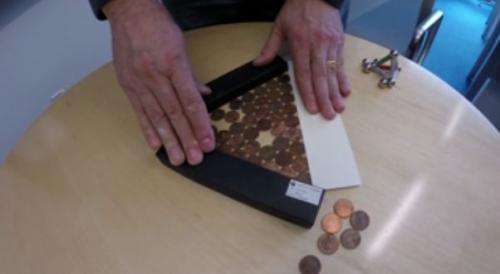Pennies reveal new insights on the nature of randomness

The concept of randomness appears across scientific disciplines, from materials science to molecular biology. Now, theoretical chemists at Princeton have challenged traditional interpretations of randomness by computationally generating random and mechanically rigid arrangements of two-dimensional hard disks, such as pennies, for the first time.
"It's amazing that something so simple as the packing of pennies can reveal to us deep ideas about the meaning of randomness or disorder," said Salvatore Torquato, professor of chemistry at Princeton and principal investigator of the report published on December 30 in the journal Proceedings of the National Academy of Sciences.
In two dimensions, conventional wisdom held that the most random arrangements of pennies were those most likely to form upon repeated packing, or in other words, most "entropically" favored. But when a group of pennies are rapidly compressed the most probable states are actually highly ordered with small imperfections—called a polycrystalline state.
"We're saying that school of thought is wrong because you can find much lower density states that have a high degree of disorder, even if they are not seen in typical experiments," Torquato said.
Torquato and coworkers proposed that randomness should be judged from the disorder of a single state as opposed to many states. "It's a new way of searching for randomness," said Morrel Cohen, a senior scholar at Princeton and the editor assigned to the article.
Using a computer algorithm, the researchers produced so-called maximally random, jammed (rigid) states as defined by a set of "order metrics." These measurements reflect features of a single configuration, such as the fluctuations of density within a system and the extent to which one penny's position can be used to predict another's.
The algorithm generated random states that have never been seen before in systems with up to approximately 200 disks. Theoretically, these maximally random states should exist for even larger systems, but are beyond the computational limits of the program.
These findings hold promise especially for the physics and chemistry of surfaces. Randomly dispersed patterns can be relayed to a 3D printer to create materials with unique properties. This may be desirable in photonics—analogous to electronics, but with photons instead of electrons—where the orientation of particles affects light's ability to travel through a material.
This work also provides a tool for measuring degrees of order that may be applied to broadly to other fields. For example, the degree of disorder in the spatial distribution of cancer cells versus healthy cells could be measured and compared for possible biological links. The next challenge in this line of research will be for experimentalists to replicate these findings in the laboratory.
More information: Existence of isostatic, maximally random jammed monodisperse hard-disk packings, Steven Atkinson, 18436–18441, DOI: 10.1073/pnas.1408371112
Journal information: Proceedings of the National Academy of Sciences
Provided by Princeton University





















